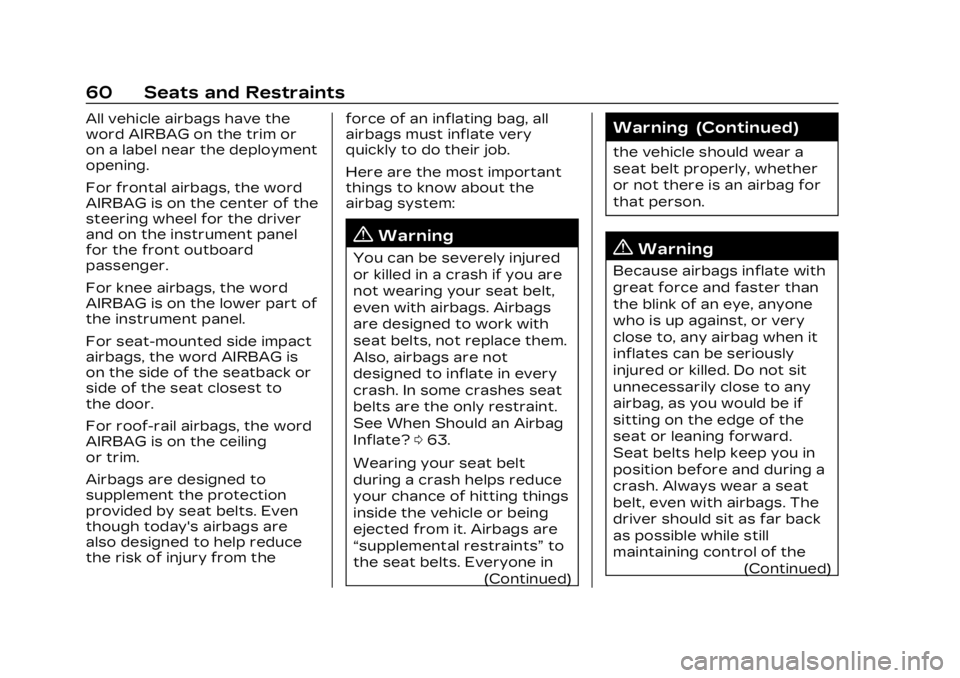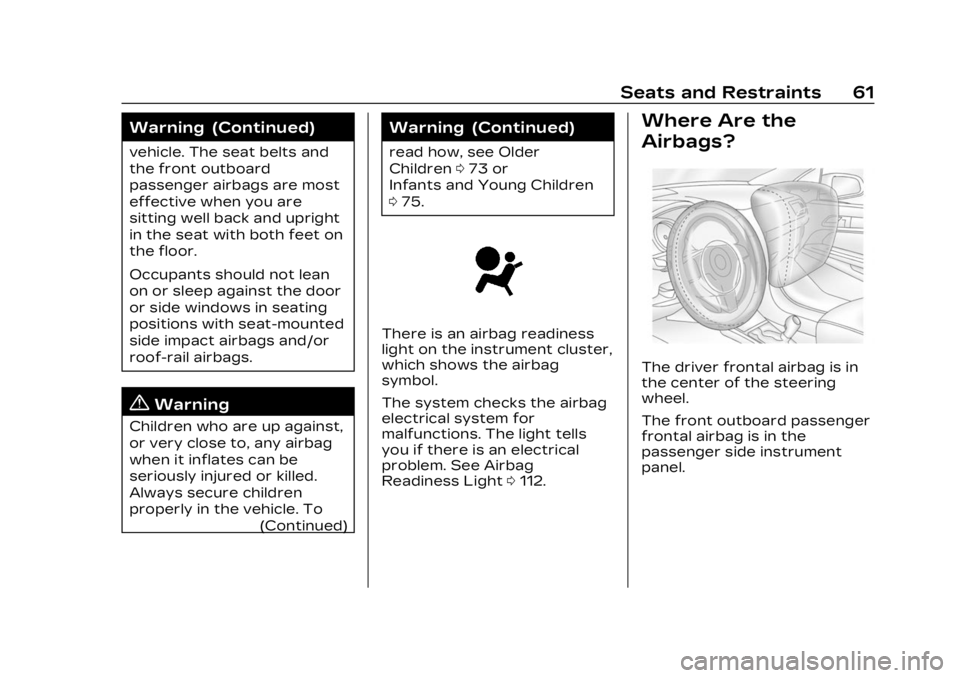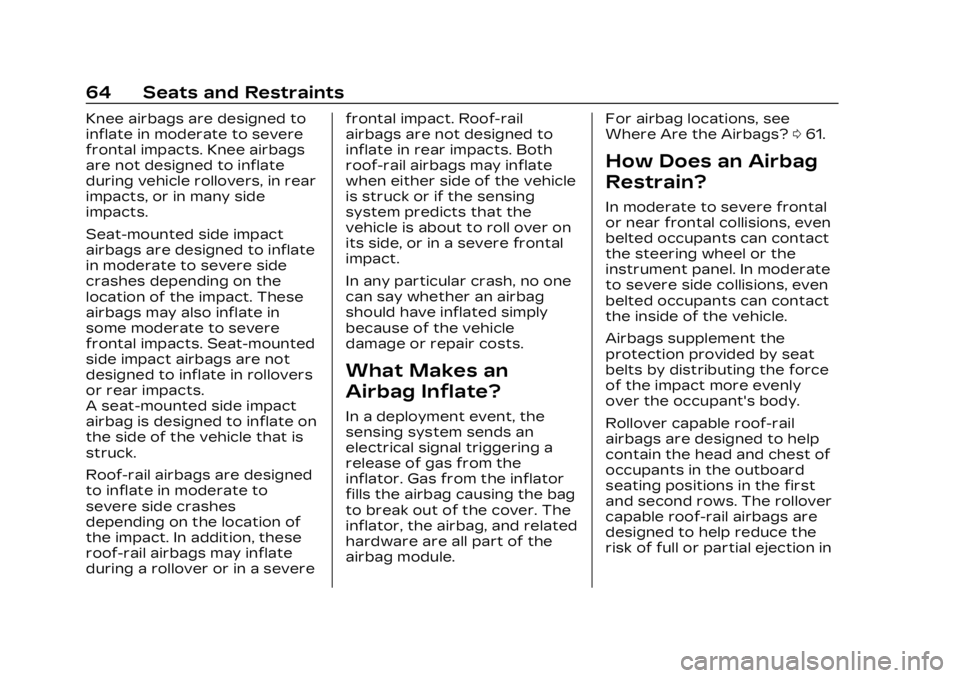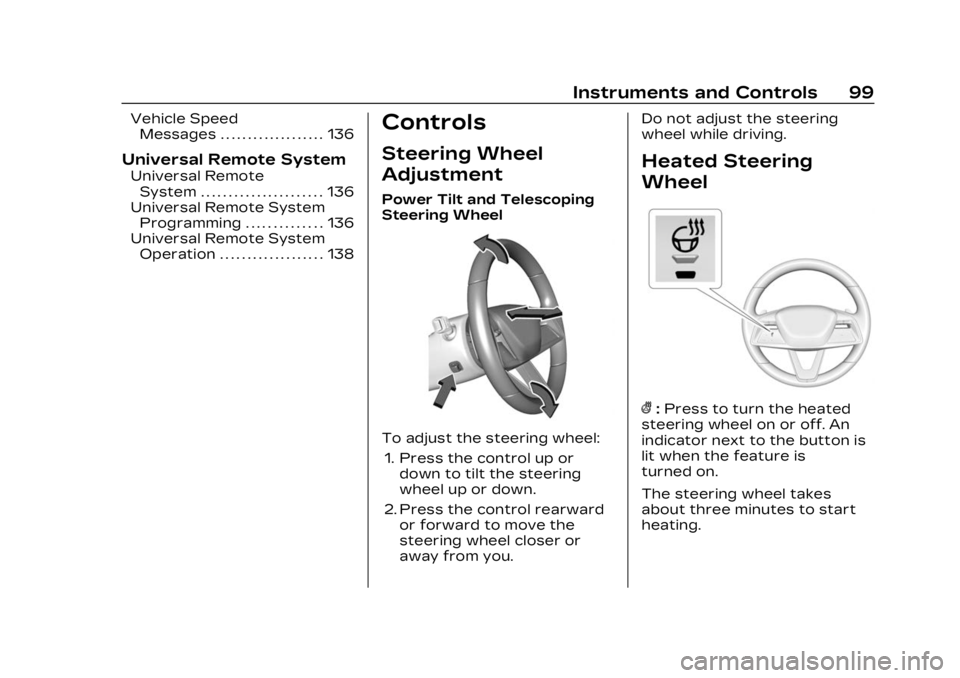2023 CADILLAC LYRIC steering wheel
[x] Cancel search: steering wheelPage 7 of 424

Cadillac Lyriq Owner Manual (GMNA-Localizing-U.S./Canada-15644413) -
2023 - CRC - 3/2/22
6 Introduction
1. Air Vents0189.
2. Turn Signal Lever. See Turn and Lane-Change Signals
0146.
Windshield Wiper/Washer
0 100.
3. Shift Lever. See Electric Drive Unit 0211.
4. Light Sensor. See Automatic Headlamp
System 0143.
5. Infotainment Display. See Introduction 0150.
Instrument Cluster 0108.
6. Instrument Panel Fuse Block 0331.
7. Glove Box 094.
8. Dual Automatic Climate Control System 0185.
9. Sliding Storage Tray. See Instrument Panel Storage
094 (If Equipped).
10. Lower Storage. See Instrument Panel Storage
094 (If Equipped).
11. Wireless Charging 0104.
12. Infotainment Controls. 13. Power Button
0206 (Out
of View).
14. Radio Controls. See Steering Wheel Controls
0152.
15. Horn 0100.
16. Steering Wheel Adjustment 099 (Out of View).
17. Adaptive Cruise Control (Advanced) 0225.
Super Cruise 0236.
Forward Collision Alert
(FCA) System 0270 (If
Equipped).
Heated Steering Wheel
0 99.
18. Hood Release. See Hood 0310.
19. Electric Parking Brake 0217.
Lane Keep Assist (LKA)
0 280 (If Equipped).
Automatic Vehicle Hold
(AVH) 0219.
Instrument Panel
Illumination Control 0146.
Page 61 of 424

Cadillac Lyriq Owner Manual (GMNA-Localizing-U.S./Canada-15644413) -
2023 - CRC - 2/23/22
60 Seats and Restraints
All vehicle airbags have the
word AIRBAG on the trim or
on a label near the deployment
opening.
For frontal airbags, the word
AIRBAG is on the center of the
steering wheel for the driver
and on the instrument panel
for the front outboard
passenger.
For knee airbags, the word
AIRBAG is on the lower part of
the instrument panel.
For seat-mounted side impact
airbags, the word AIRBAG is
on the side of the seatback or
side of the seat closest to
the door.
For roof-rail airbags, the word
AIRBAG is on the ceiling
or trim.
Airbags are designed to
supplement the protection
provided by seat belts. Even
though today's airbags are
also designed to help reduce
the risk of injury from theforce of an inflating bag, all
airbags must inflate very
quickly to do their job.
Here are the most important
things to know about the
airbag system:
{Warning
You can be severely injured
or killed in a crash if you are
not wearing your seat belt,
even with airbags. Airbags
are designed to work with
seat belts, not replace them.
Also, airbags are not
designed to inflate in every
crash. In some crashes seat
belts are the only restraint.
See When Should an Airbag
Inflate?
063.
Wearing your seat belt
during a crash helps reduce
your chance of hitting things
inside the vehicle or being
ejected from it. Airbags are
“supplemental restraints” to
the seat belts. Everyone in
(Continued)
Warning (Continued)
the vehicle should wear a
seat belt properly, whether
or not there is an airbag for
that person.
{Warning
Because airbags inflate with
great force and faster than
the blink of an eye, anyone
who is up against, or very
close to, any airbag when it
inflates can be seriously
injured or killed. Do not sit
unnecessarily close to any
airbag, as you would be if
sitting on the edge of the
seat or leaning forward.
Seat belts help keep you in
position before and during a
crash. Always wear a seat
belt, even with airbags. The
driver should sit as far back
as possible while still
maintaining control of the(Continued)
Page 62 of 424

Cadillac Lyriq Owner Manual (GMNA-Localizing-U.S./Canada-15644413) -
2023 - CRC - 2/23/22
Seats and Restraints 61
Warning (Continued)
vehicle. The seat belts and
the front outboard
passenger airbags are most
effective when you are
sitting well back and upright
in the seat with both feet on
the floor.
Occupants should not lean
on or sleep against the door
or side windows in seating
positions with seat-mounted
side impact airbags and/or
roof-rail airbags.
{Warning
Children who are up against,
or very close to, any airbag
when it inflates can be
seriously injured or killed.
Always secure children
properly in the vehicle. To(Continued)
Warning (Continued)
read how, see Older
Children073 or
Infants and Young Children
0 75.
There is an airbag readiness
light on the instrument cluster,
which shows the airbag
symbol.
The system checks the airbag
electrical system for
malfunctions. The light tells
you if there is an electrical
problem. See Airbag
Readiness Light 0112.
Where Are the
Airbags?
The driver frontal airbag is in
the center of the steering
wheel.
The front outboard passenger
frontal airbag is in the
passenger side instrument
panel.
Page 64 of 424

Cadillac Lyriq Owner Manual (GMNA-Localizing-U.S./Canada-15644413) -
2023 - CRC - 2/23/22
Seats and Restraints 63
Warning (Continued)
causing severe injury or
even death. The path of an
inflating airbag must be kept
clear. Do not put anything
between an occupant and an
airbag, and do not attach or
put anything on the steering
wheel hub or on or near any
other airbag covering.
Do not use seat accessories
that block the inflation path
of a seat-mounted side
impact airbag.
Never secure anything to
the roof of a vehicle with
roof-rail airbags by routing a
rope or tie‐down through
any door or window opening.
If you do, the path of an
inflating roof-rail airbag will
be blocked.
When Should an
Airbag Inflate?
This vehicle is equipped with
airbags. See Airbag System
059. Airbags are designed to
inflate if the impact exceeds
the specific airbag system's
deployment threshold.
Deployment thresholds are
used to predict how severe a
crash is likely to be in time for
the airbags to inflate and help
restrain the occupants. The
vehicle has electronic sensors
that help the airbag system
determine the severity of the
impact. Deployment
thresholds can vary with
specific vehicle design.
Frontal airbags are designed
to inflate in moderate to
severe frontal crashes to help
reduce the potential for
severe injuries, mainly to the
driver's or front outboard
passenger's head and chest. Whether the frontal airbags
will or should inflate is not
based primarily on how fast
the vehicle is traveling.
It depends on what is hit, the
direction of the impact, and
how quickly the vehicle
slows down.
Frontal airbags may inflate at
different crash speeds
depending on whether the
vehicle hits an object straight
on or at an angle, and whether
the object is fixed or moving,
rigid or deformable, narrow
or wide.
Frontal airbags are not
intended to inflate during
vehicle rollovers, in rear
impacts, or in many side
impacts.
In addition, the vehicle has
advanced technology frontal
airbags. Advanced technology
frontal airbags adjust the
restraint according to crash
severity.
Page 65 of 424

Cadillac Lyriq Owner Manual (GMNA-Localizing-U.S./Canada-15644413) -
2023 - CRC - 2/23/22
64 Seats and Restraints
Knee airbags are designed to
inflate in moderate to severe
frontal impacts. Knee airbags
are not designed to inflate
during vehicle rollovers, in rear
impacts, or in many side
impacts.
Seat-mounted side impact
airbags are designed to inflate
in moderate to severe side
crashes depending on the
location of the impact. These
airbags may also inflate in
some moderate to severe
frontal impacts. Seat-mounted
side impact airbags are not
designed to inflate in rollovers
or rear impacts.
A seat-mounted side impact
airbag is designed to inflate on
the side of the vehicle that is
struck.
Roof-rail airbags are designed
to inflate in moderate to
severe side crashes
depending on the location of
the impact. In addition, these
roof-rail airbags may inflate
during a rollover or in a severefrontal impact. Roof-rail
airbags are not designed to
inflate in rear impacts. Both
roof-rail airbags may inflate
when either side of the vehicle
is struck or if the sensing
system predicts that the
vehicle is about to roll over on
its side, or in a severe frontal
impact.
In any particular crash, no one
can say whether an airbag
should have inflated simply
because of the vehicle
damage or repair costs.
What Makes an
Airbag Inflate?
In a deployment event, the
sensing system sends an
electrical signal triggering a
release of gas from the
inflator. Gas from the inflator
fills the airbag causing the bag
to break out of the cover. The
inflator, the airbag, and related
hardware are all part of the
airbag module.
For airbag locations, see
Where Are the Airbags?
061.
How Does an Airbag
Restrain?
In moderate to severe frontal
or near frontal collisions, even
belted occupants can contact
the steering wheel or the
instrument panel. In moderate
to severe side collisions, even
belted occupants can contact
the inside of the vehicle.
Airbags supplement the
protection provided by seat
belts by distributing the force
of the impact more evenly
over the occupant's body.
Rollover capable roof-rail
airbags are designed to help
contain the head and chest of
occupants in the outboard
seating positions in the first
and second rows. The rollover
capable roof-rail airbags are
designed to help reduce the
risk of full or partial ejection in
Page 72 of 424

Cadillac Lyriq Owner Manual (GMNA-Localizing-U.S./Canada-15644413) -
2023 - CRC - 2/23/22
Seats and Restraints 71
put on an unoccupied seat.
If this is not desired, remove
the object from the seat.
{Warning
Stowing articles under the
passenger seat or between
the passenger seat cushion
and seatback may interfere
with the proper operation of
the passenger sensing
system.
Servicing the
Airbag-Equipped
Vehicle
Airbags affect how the vehicle
should be serviced. There are
parts of the airbag system in
several places around the
vehicle. Your dealer and the
service manual have
information about servicing
the vehicle and the airbag
system. To purchase a service
manual, see Publication
Ordering Information0394.
{Warning
For up to 10 seconds after
the vehicle is turned off and
the battery is disconnected,
an airbag can still inflate
during improper service. You
can be injured if you are
close to an airbag when it
inflates. Avoid yellow
connectors. They are
probably part of the airbag
system. Be sure to follow
proper service procedures,
and make sure the person
performing work for you is
qualified to do so.
Adding Equipment to
the Airbag-Equipped
Vehicle
Adding accessories that
change the vehicle's frame,
bumper system, height, front
end, or side sheet metal may
keep the airbag system from
working properly. The operation of the airbag
system can also be affected
by changing, including
improperly repairing or
replacing, any parts of the
following:
.Airbag system, including
airbag modules, front or side
impact sensors, sensing and
diagnostic module, or airbag
wiring
.Front seats, including
stitching, seams or zippers
.Seat belts
.Steering wheel, instrument
panel, overhead console,
ceiling trim, or pillar
garnish trim
.Inner door seals, including
speakers
Your dealer and the service
manual have information about
the location of the airbag
modules and sensors, sensing
and diagnostic module, and
airbag wiring along with the
proper replacement
procedures.
Page 99 of 424

Cadillac Lyriq Owner Manual (GMNA-Localizing-U.S./Canada-15644413) -
2023 - CRC - 2/23/22
98 Instruments and Controls
Instruments and
Controls
Controls
Steering WheelAdjustment . . . . . . . . . . . . . . . . . . 99
Heated Steering Wheel . . . 99
Horn . . . . . . . . . . . . . . . . . . . . . . . . . . . 100
Pedestrian Safety Signal . . . . . . . . . . . . . . . . . . . . . . . . 100
Windshield Wiper/ Washer . . . . . . . . . . . . . . . . . . . . . 100
Compass . . . . . . . . . . . . . . . . . . . . . 102
Clock . . . . . . . . . . . . . . . . . . . . . . . . . . . 102
Power Outlets . . . . . . . . . . . . . . 102
Wireless Charging . . . . . . . . . 104
Warning Lights, Gauges,
and Indicators
Warning Lights, Gauges, and Indicators . . . . . . . . . . . . . 108
Instrument Cluster . . . . . . . . 108
Speedometer . . . . . . . . . . . . . . . . 110
Odometer . . . . . . . . . . . . . . . . . . . . . 110
Trip Odometer . . . . . . . . . . . . . . 110
Battery Gauge (High Voltage) . . . . . . . . . . . . . . . . . . . . . 110
Power Indicator Gauge . . . . 111
Seat Belt Reminders . . . . . . . 112 Airbag Readiness Light . . . 112
Passenger Airbag Status
Indicator . . . . . . . . . . . . . . . . . . . . . 113
Charging System Light (12-Volt Battery) . . . . . . . . . . . 114
Low State of Charge Light . . . . . . . . . . . . . . . . . . . . . . . . . . 114
Charge Cord Connected Light . . . . . . . . . . . . . . . . . . . . . . . . . . 114
Battery Fault Light . . . . . . . . . 115
Propulsion Power is Limited Light . . . . . . . . . . . . . . . 115
Service Vehicle Soon Light . . . . . . . . . . . . . . . . . . . . . . . . . . 115
Brake System Warning Light . . . . . . . . . . . . . . . . . . . . . . . . . . 115
Electric Parking Brake Light . . . . . . . . . . . . . . . . . . . . . . . . . . 116
Service Electric Parking Brake Light . . . . . . . . . . . . . . . . . 116
Antilock Brake System (ABS) Warning Light . . . . . 117
Automatic Vehicle Hold (AVH) Light . . . . . . . . . . . . . . . . . . 117
Lane Keep Assist (LKA) Light . . . . . . . . . . . . . . . . . . . . . . . . . . 117
Automatic Emergency Braking (AEB) Disabled
Light . . . . . . . . . . . . . . . . . . . . . . . . . . 118 Vehicle Ahead
Indicator . . . . . . . . . . . . . . . . . . . . . 118
Pedestrian Ahead Indicator . . . . . . . . . . . . . . . . . . . . . 118
Traction Off Light . . . . . . . . . . 119
StabiliTrak OFF Light . . . . . 119
Traction Control System
(TCS)/StabiliTrak
Light . . . . . . . . . . . . . . . . . . . . . . . . . . 119
Driver Mode Control Light . . . . . . . . . . . . . . . . . . . . . . . . . 120
Tire Pressure Light . . . . . . . 120
Security Light . . . . . . . . . . . . . . . 121
Vehicle Ready Light . . . . . . . . 121
One-Pedal Driving Light . . . . . . . . . . . . . . . . . . . . . . . . . . 121
High-Beam On Light . . . . . . . 121
Lamps On Reminder . . . . . . 122
Cruise Control Light . . . . . . 122
Door Ajar Light . . . . . . . . . . . . . 122Information Displays
Charging . . . . . . . . . . . . . . . . . . . . . . 123
Driver Information Center (DIC) . . . . . . . . . . . . . . . . 132
Vehicle Information . . . . . . . . 133
Vehicle Messages
Vehicle Messages . . . . . . . . . 134
Propulsion Power Messages . . . . . . . . . . . . . . . . . . . 135
Page 100 of 424

Cadillac Lyriq Owner Manual (GMNA-Localizing-U.S./Canada-15644413) -
2023 - CRC - 2/23/22
Instruments and Controls 99
Vehicle SpeedMessages . . . . . . . . . . . . . . . . . . . 136
Universal Remote System
Universal RemoteSystem . . . . . . . . . . . . . . . . . . . . . . 136
Universal Remote System Programming . . . . . . . . . . . . . . 136
Universal Remote System Operation . . . . . . . . . . . . . . . . . . . 138
Controls
Steering Wheel
Adjustment
Power Tilt and Telescoping
Steering Wheel
To adjust the steering wheel:
1. Press the control up or down to tilt the steering
wheel up or down.
2. Press the control rearward or forward to move the
steering wheel closer or
away from you. Do not adjust the steering
wheel while driving.
Heated Steering
Wheel
(:
Press to turn the heated
steering wheel on or off. An
indicator next to the button is
lit when the feature is
turned on.
The steering wheel takes
about three minutes to start
heating.